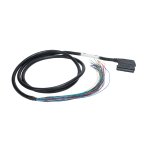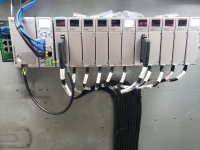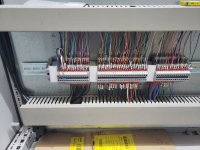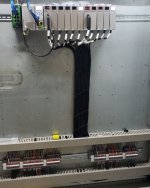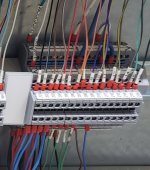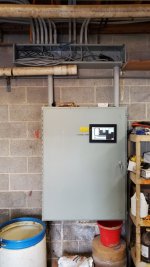Multi level blocks
5. Do any of your cables use screens/shields ? If so, you must consider how to terminate the screen/shield. "Pigtails" are generally not allowed.
Analog have them, triple level blocks have the bottom level for terminating shields.
6. The bottom part could be optimized to facilitate the cable connections better. The wire ducts seems to be on the small side IMO.
You have 4 vertical routes for the cables to enter the cabinet.
I suggest to have 2 central ladders where cables can go up, with terminals on both sides. Arranging the vertical cables in that way also saves space. Use the saved space for bigger wire ducts and/or greater space for the cables.
The ducts are narrow, but tall(which I don't care for). I Would've liked a bit bigger, but last time I went too big. Bit of a Goldilocks right now trying to figure out the right size.
Two ducts would've worked nice with bottom entry and been cleaner/nicer to work with. I'm not sure how much space it would've saved though? I would still have the same number of wires requiring the same amount of room right?
With bottom entry I would've done the two routes like you suggest
7. Screw terminals - yuck. I prefer cage-clamp for a number of reasons. One good reason is that they can save a considerable amount of space, without compromizing acessability. Because of connecting the wires from the front insted of under and above the terminal you save 40-50 mm per terminal strip.
I agree, but when I started making some of these I bought screw terminals and still have a ton of them to go through before I can switch. I don't like the idea of having both types in the same cabinet so I'll wait until supplies are lower before I switch. Maybe that's bad thinking, but I'm cheap.
8. What is the benefit of the PLC I/O via the ziplink modules ?? You have zero expansion capacity.
You have 32-channel modules with ziplink. How about using 16-channel modules and connecting directly on the PLC modules without the ziplink ?
I'm not quite understanding you here. What isn't expandable? I agree on not wiring the ziplinks to TBs like I did and the space it wasted, but I'm lost on the expansion part. I don't know that I will ever come close to hooking up all of the I/O in the cabinet. I went through everything imaginable that I would ever want to automate where its located and its still less than 75% of the capacity. A number of those were just dreams too, not something practical. Some things I could automate but choose not to because they can be serviced by someone else if I don't touch it. Beneficial for certain things. I'm currently barely using 10% of it. The only other card I will likely add is another RTD and I have room for it, the wiring and TBs.
I do understand the concept of leaving room for expansion later, but I kind of did this one backwards with the expansion already built in. I realize that can cause other issues, but at some point I decided I just needed to do something and that it wouldn't be perfect.
Thanks






